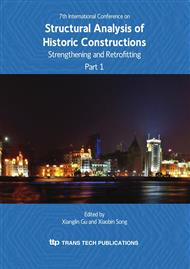p.3
p.19
p.27
p.31
p.43
p.53
p.65
p.79
p.97
In Situ Assessment of Structural Timber: State-of-the-Art, Challenges and Future Directions
Abstract:
Timber is one of the oldest structural materials and has been traditionally used in all parts of the world. Pressures on environmental sustainability lead to revitalization of timber as a modern, highly environmentally friendly and sustainable material. This new interest also sparks the attention of the research and engineering community in the structural applications involving timber. A number of techniques can be used to evaluate health, deterioration and extent of potential damage of historic structures and their components. Because timber is a natural, biodegradable, hygroscopic, and inhomogeneous material, its interaction with the environment presents challenges not normally encountered in materials typically studied by engineers. In addition, high variability of properties even within individual species makes it difficult to make inferences on properties of the investigated systems or even individual components. This requires a multidisciplinary approach and broad knowledge of disciplines spanning from biology and plant anatomy to mechanical properties and statistics. This paper will discuss some of the methods that can be deployed to evaluate historic timber and their drawbacks and limitations. Future directions and needs will be addressed in the last part of the presentation.
Info:
Periodical:
Pages:
43-52
Citation:
Online since:
October 2010
Authors:
Price:
Сopyright:
© 2010 Trans Tech Publications Ltd. All Rights Reserved
Share:
Citation:


